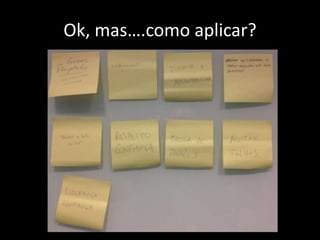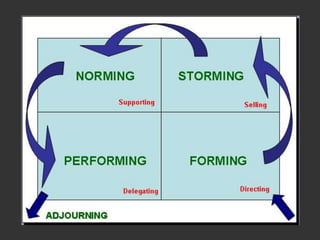Self Management
- 1. Autogerenciamento O que? Por que? Como?
- 2. "An empowered organization is one in which individuals have the knowledge, skill, desire, and opportunity to personally succeed in a way that leads to collective organizational success." Stephen R. Covey, Principle-centered Leadership
- 3. O que é?
- 4. O que é?
- 6. Por que? Why God!? Whyyyy ???
- 7. Por que?
- 12. Conclusões
Editor's Notes
- Autor do best seller “Ossetehabitos de pessoasaltamenteeficazes” e fundador do Covey Leadership center” queensina o planejamentonasorganizações. Pregamuito o autogerenciamentocomoprérequisito de instituições de sucesso.
- A self-organized, semiautonomous small group of employees whose members determine, plan, and manage their day-to-day activities and duties under reduced or no supervision. Also called self directed team or self-managed natural work team.Cards: PequenosgruposMembrosdeterminam,planejam e gerenciam as atividades do dia a dia
- A self-organized, semiautonomous small group of employees whose members determine, plan, and manage their day-to-day activities and duties under reduced or no supervision. Also called self directed team or self-managed natural work team.Cards: PequenosgruposMembrosdeterminam,planejam e gerenciam as atividades do dia a dia
- Innovation: Team members have the freedom to review and improve working practices.Commitment: Team members can become more involved in projects as a direct result of having increased autonomy and responsibility.Motivation: Team members have shared or equal responsibility so members are accountable for their actions.
- Innovation: Team members have the freedom to review and improve working practices.Commitment: Team members can become more involved in projects as a direct result of having increased autonomy and responsibility.Motivation: Team members have shared or equal responsibility so members are accountable for their actions.
- Dividir a responsabilidadeatraves de atitudes “O quevcacha?” (estimativas, roadmaps, etc)Comprometimento: AutogerenciadanãoéNãogerenciada!Troca de papéis: Aequipecomogestora!
- Dividir a responsabilidadeatraves de atitudes “O quevcacha?” (estimativas, roadmaps, etc)Comprometimento: AutogerenciadanãoéNãogerenciada!Troca de papéis: Aequipecomogestora!
- Psychologist Bruce Tuckman first came up with the memorable phrase "forming, storming, norming, and performing" in his 1965 article, "Developmental Sequence in Small Groups.1 – Formação: a equipeé um conjunto de pessoasqueestãocomeçando a formarumaunidadequeinicialmentedeverávencerdificuldades.2 – Confusão:quando as pessoascomeçam a mostrarsuamaneira de ver e de sentir, inevitavelmenteosconflitosaparecem.3 – Normatização:É a etapa de amadurecimento e acomodação, pois as pessoasentendemospontos fortes e osfracos de cadauma, comotambémseuspadrões de comportamento.4 – Desempenho: Etapa de criação de confiança, respeito, entendimento e sensocomum.5 – Aperfeiçoamento: Processo de renovar e revigorar a equipe, apósalgunsinsucessos, dificuldades e mudanças.












